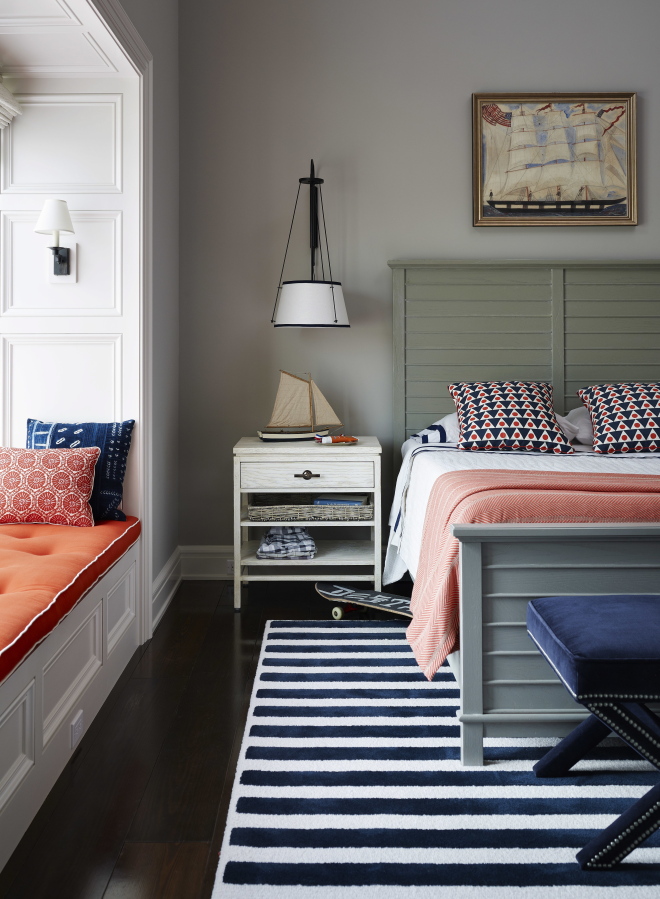The first weeks of school can be the perfect time to reboot a child’s bedroom.
Ideally, the room should be easy to keep organized and great for concentrating on homework. It also needs to be decorated in way that’s cheerfully kid-friendly and but not too age-specific, so you won’t have to redecorate too soon.
We’ve asked three interior designers — Brett Beldock of New York-based Brett Design Inc., Florida interior designer Andrew Howard, and Catherine Davin of Pittsburgh-based Davin Interiors — for some organizing and decorating strategies for children’s rooms.
Simple choices
In choosing a color palette, keep it as simple as possible, says Beldock. She suggests limiting the number of colors to create a stylish space that feels orderly. Use white paint on walls, she says, and then bring in just one bold accent color, like red, navy or magenta, perhaps through a patterned rug and colorful bedding.
Another trendy but timeless option: Use charcoal paint on the walls with crisp white trim, then add a white-and-charcoal patterned rug, and bring in bolder colors through books and keepsakes displayed on shelves. Colorful lamps are also a great way to add personality.
“We used to do baby colors, but I think the important thing is to do strong, handsome colors they can live with and grow into,” Beldock says.
Durable fabrics
For those who worry about using a lot of white in a child’s room, where it could easily get dirty, Howard notes that outdoor fabrics and rugs have become just as pleasant to the touch as indoor items, and they’re far more durable. So light colors can be much more easily cleaned than they would have been a decade ago.
Use outdoor fabrics in places where kids “might be putting their hands, and where they might sit,” he says. Even if your child is neat, “his friend might wipe Cheetos all over everything and not think about it.”
Patterns, too, can help hide wear and tear. Davin recommends using a patterned carpet that’s “forgiving with stains” to add color and style to a child’s room. “By the time they grow out of it, it might be time to change the carpet anyway,” she says.
She adds that organic cottons and other fabrics made without harsh dyes can be durable, and are becoming more popular with health-conscious parents.
Open, organized spaces
“Don’t over-furnish,” says Davin, because kids are likely to want a big open space to spread out on. Include only furniture that’s necessary.
And while some open shelving is great for displaying favorite items, all three designers recommend plenty of closed storage for kids’ rooms. Deep drawers, bins with lids and cabinets with doors will all help kids stash their items.
Davin suggests hunting for flea market finds, like old armoires or Queen Anne dressers offering plenty of space. “You could paint it bright pink or shiny black or whatever color you need,” she says. “We never do that ‘matched set of furniture for a child’s room’ anymore.”
Bunk beds with drawers are also useful, and even young kids can learn to put away their toys and clothes in these low drawers.
Remember, says Howard, that you will always need a bit more storage than you think. So rather than filling all storage to capacity, keep one drawer or one big bin on a shelf empty for quick cleanup of clutter.
Small room strategies
Large furniture pieces can make a small room feel smaller, and yet some of them may be needed. Beldock says one creative strategy to keep desks and storage units from dominating a room is to use transparent, durable Lucite for these large pieces. For one design project, Beldock created an entire wall of Lucite bookcases, and she has designed a clear Lucite desk for CB2.
Another small-space strategy: Howard suggests adding built-in storage beneath window seats or anywhere else there might be unused space.
For lighting in small rooms, wall sconces are great because you don’t have to worry about kids knocking lamps over.
But even in small rooms, Beldock suggests investing in a full-size desk. When a child is young, it’s nice to be able to pull up a second chair at the desk for a tutor or family member helping with homework. Once kids get older, they’ll be ready to use that full-size desk all by themselves.
Touch of personality
Although the goal is a timeless space that won’t need too much redecorating as a child grows, be sure to incorporate a few special items that express a child’s interests. Davin often includes framed prints like movie posters or depictions of favorite animals, or one big item like a surfboard. “For one little girl, we did a swing chair and fairy lights in her room,” Davin says. The items don’t have to be expensive, she says, but they should be chosen to highlight what the child loves.
Howard agrees, but cautions parents to remember how easily kids’ tastes can change.
“If they like blue now, they’re going to like red tomorrow,” he says. So strike a balance between giving the child a voice in choosing some items, and letting the grown-ups make the bigger design decisions.



